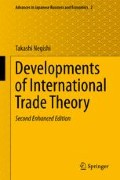Abstract
The marginal revolution against the classical economics is often attributed to W. S. Jevons, C. Menger, and L. Walras, who published their works in 1870s. From the point of view of international trade theory, however, we may also add the name of A. Marshall, though his Principles of Economics was published in 1890. As a matter of fact, his early tracts on The pure theory of foreign trade and The pure theory of domestic value are both dated 1879. Marshall reworked some of the theories of J. S. Mill into rigorous diagrams, which includes, among others, those of Marshallian offer curves to study the equilibrium terms of trade in a two-commodity two-country model. Marshall introduced the graphic apparatus of offer curves, though he did not show how they are derived from the underlying demand and production. It was left for later day’s economists, for example, Meade (1952), who skillfully derived offer curves by the use of trade indifference curves.
Access this chapter
Tax calculation will be finalised at checkout
Purchases are for personal use only
Notes
- 1.
A. Marshall (1842–1924) was professor of economics at the University of Cambridge. Against Walras’s general equilibrium theory of a closed economy, generally he tried to develop partial equilibrium theory of single industries and forged many analytical instruments still useful in applied economics.
- 2.
Edgeworth (1845–1926) was professor of economics at Oxford and founded, with Walras, the basis of modern general equilibrium theory.
- 3.
See Newman (1965, p. 104), e.g., for who first called the curves offer curves.
- 4.
Bibliography
Edgeworth, F. Y. (1925). Papers relating to political economy. London: Macmillan.
Gandolfo, G. (1986). International economics, vol. 1. Berlin: Springer.
Marshall, A. (1879)[1975]. The pure theory of foreign trade. In J. K. Whitaker (Ed.), The early economic writings of Alfred Marshall, 1867–90, vol. 2 (pp. 111–181). London: Macmillan.
Meade, J. E. (1952). A geometry of international trade. London: Allen & Unwin.
Newman, P. (1965). The theory of exchange. Englewood Cliffs, NJ: Prentice-Hall.
Samuelson, P. A. (1955). Foundations of economic analysis. Cambridge, MA: Harvard University Press.
Takayama, A. (1972). International trade. New York: Holt, Rinehart and Winston.
Author information
Authors and Affiliations
Rights and permissions
Copyright information
© 2014 Springer Japan
About this chapter
Cite this chapter
Negishi, T., Negishi, T. (2014). Marshall and Offer Curve. In: Developments of International Trade Theory. Advances in Japanese Business and Economics, vol 2. Springer, Tokyo. https://doi.org/10.1007/978-4-431-54433-3_8
Download citation
DOI: https://doi.org/10.1007/978-4-431-54433-3_8
Published:
Publisher Name: Springer, Tokyo
Print ISBN: 978-4-431-54432-6
Online ISBN: 978-4-431-54433-3
eBook Packages: Business and EconomicsEconomics and Finance (R0)

